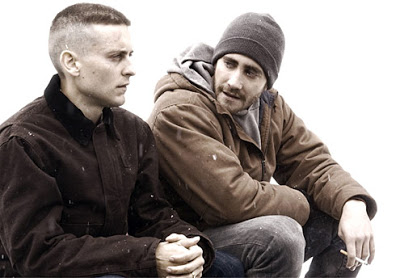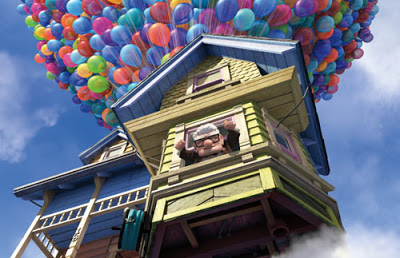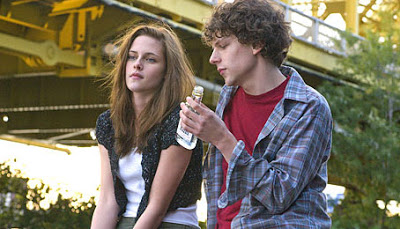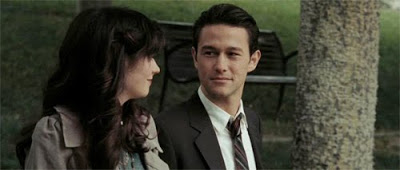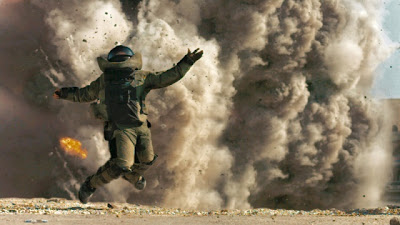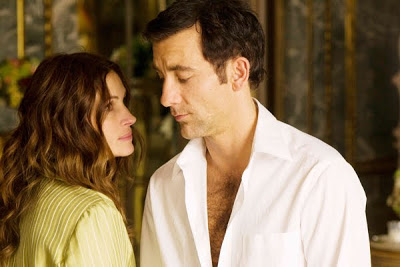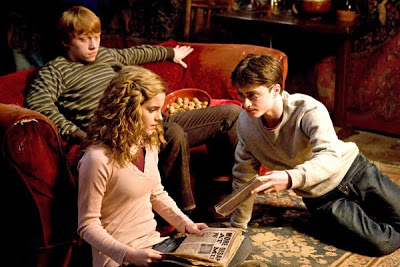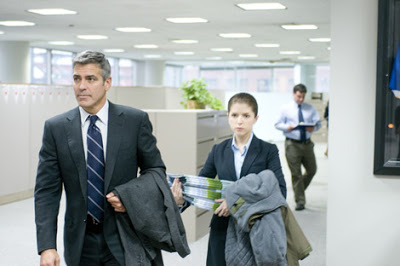Before getting to the best films of 2009, a quick recap of my Oscar performance. (Yeah, from four months ago. I’ve been busy. Or lazy. Whatever.) Of the 21 categories I predicted, I hit correctly on 17 of them, or 81%. That’s my high-water mark since 2003 (when The Lord of the Rings: The Fellowship of the Ring was such a juggernaut that it could have turned Grady Little into Nostradamus), so I’m reasonably pleased overall. I’m disappointed that I missed on Best Original Screenplay, where Best Picture winner The Hurt Locker held off Tarantino’s edgier script for Inglourious Basterds, and I’m shocked – shocked – that Precious defeated Up in the Air for Best Adapted Screenplay. But otherwise, it’s hard to complain about shooting over 80%. For what it’s worth, I’m completely confident that my success rate will dip dramatically in 2010.
O.K., on to everyone’s favorite feature, my Top 10 list for the year in film. Looking back on the year at the movies as a whole, I have to regard it with a sense of apathy that’s becoming alarmingly familiar. I saw 88 different movies in the theatre in 2009, and very few of them generated true enthusiasm from me. Don’t get me wrong, I liked a considerable number of the films that I watched. That’s normal for me – if I didn’t like most movies I watched, I wouldn’t watch so many. But I don’t want to like movies. I want to love them. And whether it’s a result of a shift in my personal ideology (could my taste as a critic actually be maturing? I doubt it) or a decline in the quality of both studio and art-house fare (a more disturbing theory), I’m having a hard time loving movies these days. The simple truth is that, while I’m frequently content with what I see, I’m far less likely to actively stump for the vast majority of it. And that’s a shame, because I want other people to see movies. They’re my primary passion in life, and if people stop seeing them, then during conversation I’ll be forced to resort to riffing about the majesty of Jon Lester’s cut fastball in order to keep myself entertained.
Of course, not all is lost. Most movies I watch provide at minimum a satisfactory dosage of entertainment, and I remain indefatigable in my optimism about the future state of cinema (well, as long as 3-D doesn’t become the global standard, but let’s not go there just yet). In other words, I won’t stop going to the theatre (or shutting down this site) anytime soon. Regardless, even in such a mediocre year as 2009, the following 10 films are all superlative examples of moviemaking and are well worth seeking out.
So fire up those Netflix queues, because the following together represent a decathlon of movies you shouldn’t miss. The Manifesto now presents its list of the Best 10 Films of 2009:
Honorable Mention: An Education, In the Loop, The Informant!, Inglorious Basterds, The Road.
10. Brothers. Jim Sheridan’s taut exploration of a family nearly ruined by the horrors of war would likely find itself several notches higher on this list, were it not a rather slavish interpretation of Susanne Bier’s 2004 Danish film of the same name. But just because Sheridan is concocting a remake shouldn’t diminish the skill with which he builds tension within the small-scale, claustrophobic setting of a suburban household. The movie reaches its dramatic peak during a seemingly innocuous dinner-table conversation, when the boiling tension of the preceding 90 minutes suddenly erupts in volcanic fury. (It’s worth noting that Sheridan’s handling of the scene marks a significant improvement from Bier’s version.) Uniformly excellent performances from Jake Gyllenhaal, Natalie Portman, and (most notably) Tobey Maguire elevate the potentially schlocky material into an enthralling melodrama.
9. Up. It would have been hard to blame the maestros at Pixar if, following their magnum opus that was Wall-E, they retreated to somewhat more conventional fare. They didn’t. True, Up is in many ways a straightforward tale, featuring classical elements such as father-son bonding, fast-paced action sequences, and a blunt thematic focus on the importance of friendship and loyalty. Of course, it also features a geriatric flying a house powered by balloons. Yet the fiendish originality of Pete Docter’s and Bob Peterson’s premise is matched with the usual Pixar accoutrements: dazzling animation, whip-smart dialogue, and a savvy blend of humor and pathos. The movie also contains the most moving cinematic sequence of the year, a four-minute silent montage that doubles as a paean to the magnificent mundanity of married life.
(Note: Before you watch that clip, you might want to have some tissues handy. I’m just saying.)
8. Adventureland. Many critics – including this one – often deride mainstream movies for focusing too much on elements like plot and action while paying too little attention to their characters. But character-driven drama itself isn’t all that easy, and many quiet, pseudo-intimate pictures that attempt to give their protagonists depth and shading at the expense of plot just wind up being profoundly boring. (See: 35 Shots of Rum.) Adventureland, however, is the best kind of character-driven film. It doesn’t have much of a plot: A post-grad (played by the incomparably anxious Jesse Eisenberg) needs to earn some cash, so he takes a dead-end job at an amusement park, where he falls in love with Kristen Stewart, that sneakily talented actress who can be fiercely authentic when she isn’t choosing between vampires and werewolves in the Twilight films (though sometimes – nay, often – even then). That’s pretty much it, but the movie – which also includes splendid supporting work from Ryan Reynolds and Martin Starr – is an unassuming marvel, one in which we become deeply invested in the lead characters simply because they seem like real people. The characters in Adventureland are warm, funny, and richly detailed. So is the movie.
7. Julia. I find very few movies to be seriously difficult to watch. I don’t mean that in the Paranormal Activity sense, when you’re constantly terrified that something is about to lunge at the camera (though there’s a certain value to that too). I mean it in the sense where I’m actually disturbed by the events taking place on-screen. Julia is such a movie. It is not fun to watch. In fact, I almost find it difficult to recommend, given how it resulted in me squirming in queasy fear for more than two hours. But it is furiously compelling cinema, the kind that clamps viewers in their seats and refuses to yield. It also houses a watershed performance from Tilda Swinton that sets new standards for an actress’ ability to disappear into her character. Did I enjoy this movie? Not exactly, but that doesn’t inhibit it from its status as one of the best films of the year.
6. (500) Days of Summer. There is so much to like about this movie. There’s the acting, most impressively a rangy, enormously sympathetic performance from Joseph Gordon-Levitt (this would be a star-making turn if Gordon-Levitt weren’t, at least in my mind, already a star). There’s the script from Scott Neustadter and Michael H. Weber, churning with sharp wit and sharper insights. And there’s the direction from Marc Webb, a filmmaker making his debut with startling audacity. It would hardly be advisable for a first-time director helming a romantic dramedy to take so many bold chances, but nearly all of Webb’s flourishes work. The two most memorable are polar opposites in tone: the first is an enchanting fantasy sequence in which Gordon-Levitt seems to have wandered into Amy Adams’ world in Enchanted, while the second is a devastating scene in which his romantic expectations are coldly juxtaposed against his reality. (The former is set to a preposterous Hall & Oates number, while during the latter, Regina Spektor’s operatic “Hero” plays with icy clarity.) But most of all – underlying all of the wry dialogue and nuanced acting, the visual dexterity and spellbinding nonlinear chronology – there is the deep sense of truth. Relationships don’t always work. Sometimes there isn’t a reason; there are no bad people, and no one makes any bad decisions or mistreats the other. Sometimes they just don’t work because one party doesn’t feel it. Such a starkly realistic observation may leave the audience shaken, but the movie is all the more perceptive for it.
5. The Hurt Locker. It’s become commonplace for the blogosphere to ridicule the choices of the Academy of Motion Picture Arts and Sciences, and while I’ll concede that the voters make their fair share of gaffes every year, they’re on a strong four-year run when it comes to Best Picture winners. (Doubtless they’re atoning for honoring Crash in 2005.) The latest, Kathryn Bigelow’s gripping examination of a bomb disarmament unit in Iraq, defies genre tagging. It’s technically a war movie, but it isn’t about winning and losing as much as surviving, as well as the unique, visceral thrill of combat. What do I know about combat? Not a thing, but Bigelow creates a terrific sense of verisimilitude, thrusting us into the action with nary an explanatory voiceover to be found. Jeremy Renner is at his brilliant, laconic best, but this is Bigelow’s movie all the way, and the director – an inveterate master of tremulous suspense – ratchets up the tension with one riveting set piece after another. The Hurt Locker may not engage on much of an emotional level, but we’re on too much of a combat high to care.
4. Duplicity. A movie about dueling intelligence agents who are simultaneously secret lovers but just might be trying to kill each other sounds like it could either be deathly serious (think Prizzi’s Honor for the espionage age) or seriously dumb (think Mr. and Mrs. Smith). It’s a marvel, then, that Tony Gilroy’s second feature (following up on the stupendous Michael Clayton) is both acutely intense – the stakes here are real – and pervasively, overwhelmingly fun. Gilroy is an austere technician, and Duplicity – with its intricately composed closeups and expansive depth of field – is a supreme work of craftsmanship that recalls the nimble ingenuity of the Coen Brothers. Yet it is also a rollicking good time, with crackling chemistry (Clive Owen and Julia Roberts are both in peak form) and a brilliant, plot-twist-a-minute screenplay that keeps us guessing in the best possible way. Here is a movie that effortlessly engages its audience in terms of both plot and character. The behavior on display may be duplicitous, but the pleasure Duplicity dispenses is singularly charming.
3. Avatar. I addressed it in considerable detail here, but the biggest movie in the history of the world – by the director with the biggest ego in the history of mankind (well, except maybe this guy) – turns out to be up to snuff. Sure, Avatar is shamelessly derivative, politically obvious, and entirely bombastic. It is also utterly spectacular. Featuring an astonishing assortment of environments, animals, and war machines, James Cameron wields his gift for technological wizardry with such meticulous flair that he creates a wholly new world that is, quite simply, extraordinary. The story he sets in this world may be familiar, but it is so appealing, and its setting so absorbing, that we seem to be experiencing it for the first time. I go to the movies in part to be transported away from the dreariness of reality and enjoy the majesty of something new. Many films try to accomplish this; few succeed. Avatar does, and gloriously.
2. Harry Potter and the Half-Blood Prince. I don’t have much to say. Either you embrace this franchise for what it is – a canny synergy of new-age cinematic technique and tried-and-true themes of vengeance, friendship, and bravery, all steeped in its own unique, immaculately detailed mythology – or you don’t. All I know is that I’ve read the book four times (that’s all?), and when Harry and Dumbledore were in that cave – a setting seemingly leeched of all color so that it appeared to have been filmed in black-and-white – I still felt breathless, waiting in terror for what was going to happen next. Director David Yates – teaming with an extraordinarily accomplished cast of actors, not to mention a game screenwriter (Steve Kloves) and virtuoso cinematographer (Bruno Delbonnel) – has accomplished what would have seemed impossible: He’s done J.K. Rowling’s fans proud.
1. Up in the Air. It’s the rare motion picture that can be breezily enjoyable and somehow still pack an uncompromising emotional punch. For the majority of its slender runtime, Jason Reitman’s look at the savagery of contemporary corporate culture is a sly, jaunty exercise in romantic interplay, easily pleasing its audience with whimsical sight gags and smart-but-realistic dialogue. Then it pulls out the rug and leaves us heartbroken. This isn’t to suggest that Up in the Air isn’t enjoyable; indeed, on balance, it’s the most crowd-pleasing movie of 2009. But it’s also the most honest about the behavior of both corporations and people. Juggling such an assemblage of emotions might have resulted in an ungainly film, but Reitman – who matures with each movie he makes (his first two were Thank You for Smoking and Juno) – achieves an uncanny balance between wry, touching comedy and quiet, human drama. Compared to the prior two selections on this list, Up in the Air may appear to be a small film by comparison, but there’s no denying the magnitude of its excellence.
Till next year.
Jeremy Beck is the editor-in-chief of MovieManifesto. He watches more movies and television than he probably should.

